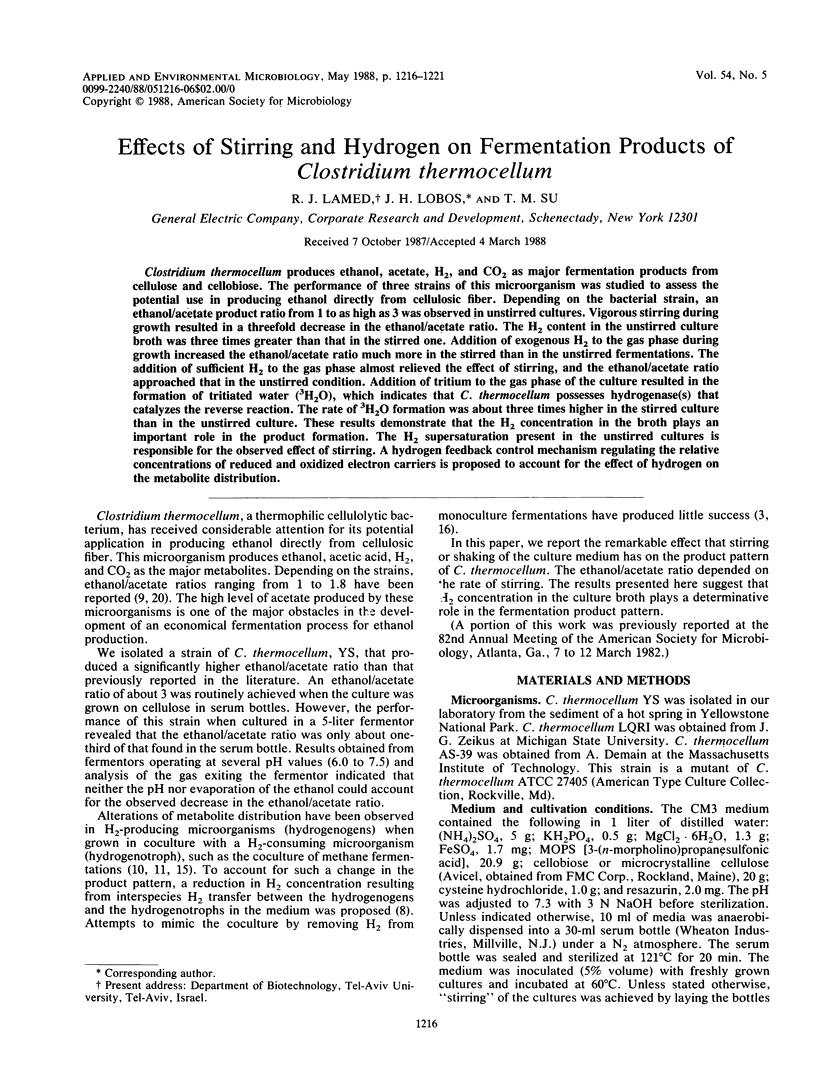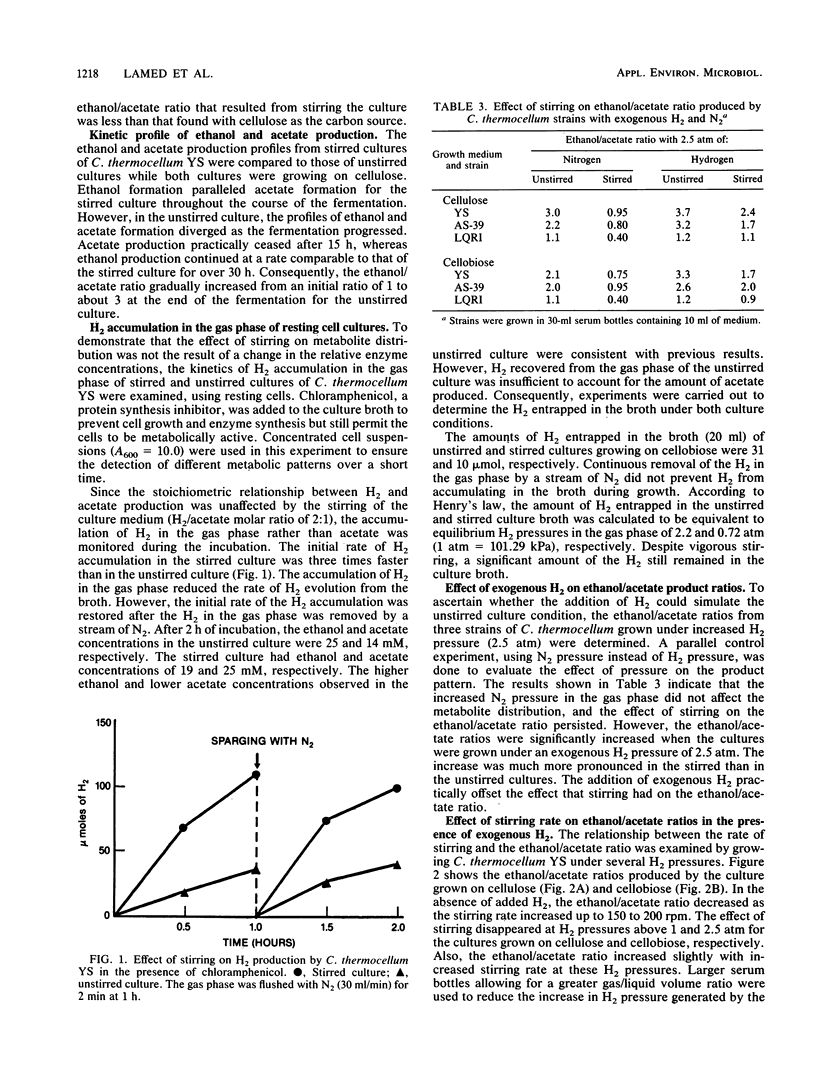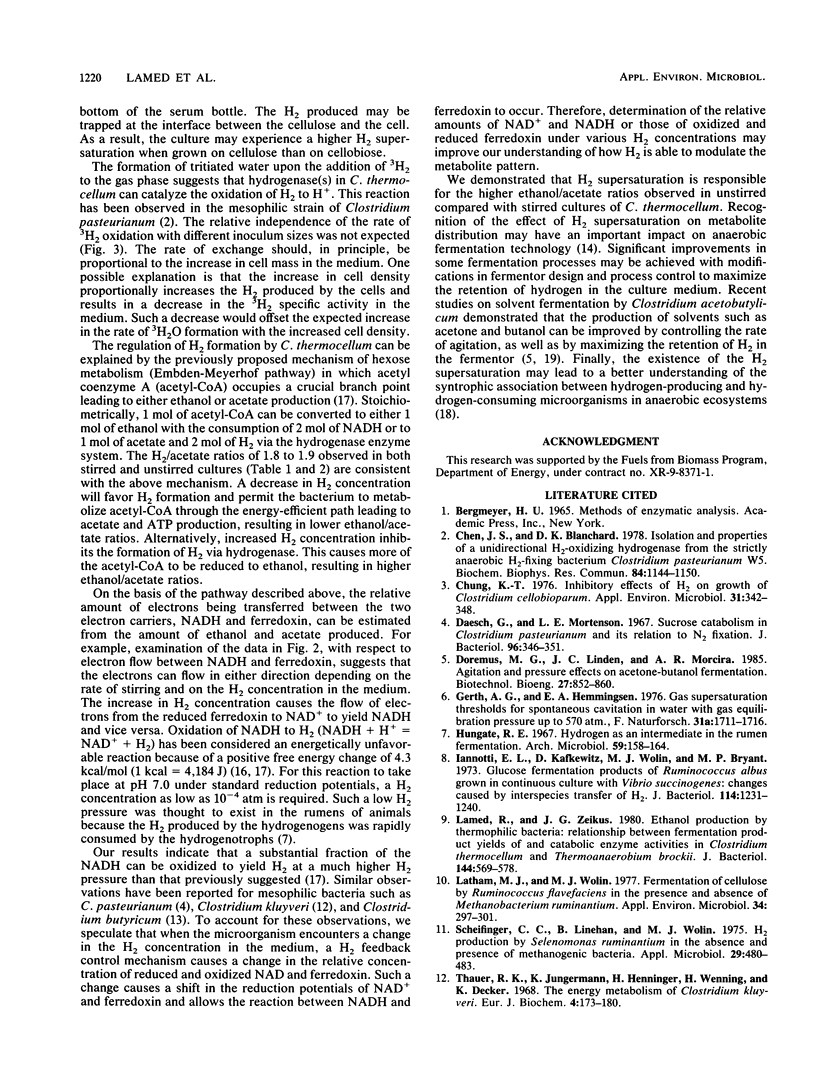Abstract
Clostridium thermocellum produces ethanol, acetate, H2, and CO2 as major fermentation products from cellulose and cellobiose. The performance of three strains of this microorganism was studied to assess the potential use in producing ethanol directly from cellulosic fiber. Depending on the bacterial strain, an ethanol/acetate product ratio from 1 to as high as 3 was observed in unstirred cultures. Vigorous stirring during growth resulted in a threefold decrease in the ethanol/acetate ratio. The H2 content in the unstirred culture broth was three times greater than that in the stirred one. Addition of exogenous H2 to the gas phase during growth increased the ethanol/acetate ratio much more in the stirred than in the unstirred fermentations. The addition of sufficient H2 to the gas phase almost relieved the effect of stirring, and the ethanol/acetate ratio approached that in the unstirred condition. Addition of tritium to the gas phase of the culture resulted in the formation of tritiated water (3H2O), which indicates that C. thermocellum possesses hydrogenase(s) that catalyzes the reverse reaction. The rate of 3H2O formation was about three times higher in the stirred culture than in the unstirred culture. These results demonstrate that the H2 concentration in the broth plays an important role in the product formation. The H2 supersaturation present in the unstirred cultures is responsible for the observed effect of stirring. A hydrogen feedback control mechanism regulating the relative concentrations of reduced and oxidized electron carriers is proposed to account for the effect of hydrogen on the metabolite distribution.
Full text
PDF





Selected References
These references are in PubMed. This may not be the complete list of references from this article.
- Chen J. S., Blanchard D. K. Isolation and properties of a unidirectional H2-oxidizing hydrogenase from the strictly anaerobic N2-fixing bacterium Clostridium pasteurianum W5. Biochem Biophys Res Commun. 1978 Oct 30;84(4):1144–1150. doi: 10.1016/0006-291x(78)91703-5. [DOI] [PubMed] [Google Scholar]
- Chung K. T. Inhibitory effects of H2 on growth of Clostridium cellobioparum. Appl Environ Microbiol. 1976 Mar;31(3):342–348. doi: 10.1128/aem.31.3.342-348.1976. [DOI] [PMC free article] [PubMed] [Google Scholar]
- Daesch G., Mortenson L. E. Sucrose catabolism in Clostridium pasteurianum and its relation to N2 fixation. J Bacteriol. 1968 Aug;96(2):346–351. doi: 10.1128/jb.96.2.346-351.1968. [DOI] [PMC free article] [PubMed] [Google Scholar]
- Hungate R. E. Hydrogen as an intermediate in the rumen fermentation. Arch Mikrobiol. 1967;59(1):158–164. doi: 10.1007/BF00406327. [DOI] [PubMed] [Google Scholar]
- Iannotti E. L., Kafkewitz D., Wolin M. J., Bryant M. P. Glucose fermentation products in Ruminococcus albus grown in continuous culture with Vibrio succinogenes: changes caused by interspecies transfer of H 2 . J Bacteriol. 1973 Jun;114(3):1231–1240. doi: 10.1128/jb.114.3.1231-1240.1973. [DOI] [PMC free article] [PubMed] [Google Scholar]
- Lamed R., Zeikus J. G. Ethanol production by thermophilic bacteria: relationship between fermentation product yields of and catabolic enzyme activities in Clostridium thermocellum and Thermoanaerobium brockii. J Bacteriol. 1980 Nov;144(2):569–578. doi: 10.1128/jb.144.2.569-578.1980. [DOI] [PMC free article] [PubMed] [Google Scholar]
- Latham M. J., Wolin M. J. Fermentation of cellulose by Ruminococcus flavefaciens in the presence and absence of Methanobacterium ruminantium. Appl Environ Microbiol. 1977 Sep;34(3):297–301. doi: 10.1128/aem.34.3.297-301.1977. [DOI] [PMC free article] [PubMed] [Google Scholar]
- Scheifinger C. C., Linehan B., Wolin M. J. H2 production by Selenomonas ruminantium in the absence and presence of methanogenic bacteria. Appl Microbiol. 1975 Apr;29(4):480–483. doi: 10.1128/am.29.4.480-483.1975. [DOI] [PMC free article] [PubMed] [Google Scholar]
- Thauer R. K., Jungermann K., Henninger H., Wenning J., Decker K. The energy metabolism of Clostridium kluyveri. Eur J Biochem. 1968 Apr 3;4(2):173–180. doi: 10.1111/j.1432-1033.1968.tb00189.x. [DOI] [PubMed] [Google Scholar]
- Weimer P. J., Zeikus J. G. Fermentation of cellulose and cellobiose by Clostridium thermocellum in the absence of Methanobacterium thermoautotrophicum. Appl Environ Microbiol. 1977 Feb;33(2):289–297. doi: 10.1128/aem.33.2.289-297.1977. [DOI] [PMC free article] [PubMed] [Google Scholar]
- Wolin M. J. Metabolic interactions among intestinal microorganisms. Am J Clin Nutr. 1974 Nov;27(11):1320–1328. doi: 10.1093/ajcn/27.11.1320. [DOI] [PubMed] [Google Scholar]


